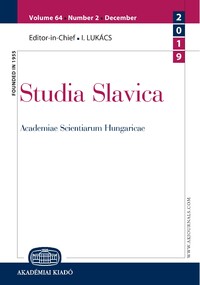Кирилична частина Реймського Євангелія – важлива пам’ятка давньоруськоукраїнської книжної писемності
The Cyrillic Part of the Reims Gospel as an Important Monument of Ancient Ruthenian-Ukrainian Bookwriting
Author(s): Viktor MoysiyenkoSubject(s): Cultural history, Eastern Slavic Languages, History of Religion
Published by: Akadémiai Kiadó
Keywords: Reims Gospel; Cyrillic alphabet; Glagolitic alphabet; Church Slavonic; Old Ukrainian; written monument; orthography; dialectal peculiarities
Summary/Abstract: The present paper analyzes the orthographic and linguistic features of the Cyrillic part of the Reims Gospel. Today, this monument is controversial in Slavic studies: the problems of the place and time of its creation and the questions about its writer have not been finally resolved yet. The opinions of researchers on this subject are very different: some scholars believe that book was brought to France by the daughter of Ukrainian Prince Yaroslav the Wise, Anne, who married the King of France Henry I. Others deny this idea and associate its creation with the name of St. Procopius from Bohemia, who allegedly wrote this Gospel, according to the appendix placed at the end of the Glagolitic part. There is also a hypothesis about the Serbian origin of the book. We analyzed various hypotheses, starting from the early studies of the Reims Gospel (V. Hanka, O. Sobolevsky, L. Leger, etc.), to subsequent ones (Yu. Shevelyov, P. Kurinny, L. Zhukovskaya, I. Tóth, etc.) and recent studies (E. Lunyak, V. Alexandrovich, T. Mironova, E. Bikkinina, G. Prikhodko, M. Fougeron, etc.). The conclusions of researchers who studied the palaeographic, graphic, orthographic, and linguistic characteristics of the manuscript in different years were taken into account and critically comprehended. For the first time in Slavic studies, attention was paid to the comparison of the analyzed Gospel with the orthographic and linguistic features of the monuments of the Kyiv written school and the Ukrainian dialectal features. It is concluded that the dialectal features observed in the Reims Gospel correspond to accurately dated and localized Kyiv monuments of the second part of the 11th century. The orthography of the manuscript does not make it possible to take the book outside the 11th century. A comparison with orthographic features of Ostromir Gospel, Svyatoslav’s Collected Works, and Archangel’s Gospel gives many grounds for generalization about the earlier time of creation of the Reims Gospel. It is clearly distinguished from the above-mentioned monuments by a number of original writings: singularity, the ending of lines on vowels and consonants, almost complete absence of iotated, the characteristic use of diacritical marks, etc. The monument was created at a time when there was no established Old Ruthenian edition of the Church Slavonic language. Apparently, the writer created the Ruthenian written usus by himself and introduced the first Russian orthographic features. The writer of the manuscript was a Ruthenian, most likely a Kyivan
Journal: Studia Slavica Academiae Scientiarum Hungaricae
- Issue Year: 65/2020
- Issue No: 1
- Page Range: 115-128
- Page Count: 14
- Language: Ukrainian
- Content File-PDF

